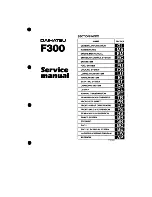
can generate temperatures high enough to destroy
the clutch.
Clutch Operation
Clutch Break-In
The clutch may slip for a short time while the friction
surfaces break-in on a new or newly-installed clutch.
NOTICE
Do not allow the clutch to slip longer than two
seconds. Clutch slippage for longer than two
seconds may severely damage the clutch disc,
pressure plate, or flywheel. Damage caused by
clutch slippage due to improper break-in is not
warrantable.
During initial operation of a new vehicle or a vehicle
with a new clutch, check for clutch slippage during
acceleration. If the clutch slips, decelerate until the
clutch does not slip. Allow the clutch to cool 15 to 30
seconds, then gradually accelerate again. If the
clutch continues to slip, repeat the procedure as
many as five times. If the clutch slips after five at-
tempts, stop the vehicle and allow the clutch to cool
for at least one hour. Notify your Freightliner dealer
of the problem.
Moving the Vehicle in the Proper Gear
An empty vehicle can be started in a higher gear
than can a partially- or fully-loaded vehicle. Select
the gear combination that allows the vehicle to start
moving with an idling engine or, if necessary, just
enough throttle to prevent stalling the engine.
Gear Shifting Techniques
Upshift into a higher gear only when the vehicle
speed allows the transmission input shaft speed to
match the flywheel speed when engaging the clutch.
This technique results in the smallest speed differ-
ence between the clutch disc and the flywheel, and
causes the least heat and wear on the clutch assem-
bly. When downshifting, increase the input shaft
speed to match the flywheel by slightly revving the
engine.
Vehicle Loading
Clutches are designed for specific vehicle applica-
tions and loads.
NOTICE
Exceeding vehicle load limits can result in dam-
age to the clutch and the entire powertrain.
Clutch Brake
Apply the clutch brake by depressing the clutch
pedal all the way to the floor plate. The last part of
pedal travel will compress the clutch brake plates
together, stopping the transmission input shaft. The
clutch brake stops the transmission gears from rotat-
ing in order to quickly engage a transmission gear
after idling in neutral.
NOTICE
Never apply the clutch brake when making down-
shifts or upshifts. If the clutch brake is applied
when the vehicle is moving, the clutch brake will
try to stop or decelerate the vehicle, causing
rapid wear of the clutch brake friction discs. Con-
siderable heat will be generated, causing damage
to the release bearings and the transmission
front bearings.
Using the Clutch
Use the clutch pedal only when starting the engine,
launching the vehicle from a stop, or shifting. To
launch a stationary vehicle, depress the clutch pedal
all the way to the floor plate (see
Clutch Brake
above) and shift from neutral to a low gear. Slowly
raise your foot until the clutch starts to engage. In
this position the clutch is starting to connect the
transmission input shaft to the flywheel and is caus-
ing the most heat and wear. Slightly increase the en-
gine speed and smoothly allow the clutch pedal to
return to the rest position. Do not allow the clutch to
remain in the partially-engaged position any longer
than necessary to obtain a smooth start.
Double-clutch to shift gears while the vehicle is mov-
ing. Depress the clutch pedal most of the way in, but
not all the way to the floor plate. Depressing the
clutch pedal to the floor plate will engage the clutch
brake. Shift the transmission into neutral and fully
release the clutch pedal. When upshifting, wait for
the engine speed to decrease to the road speed.
When downshifting, increase the engine speed to
match the road speed. Fully release the clutch pedal
after completing the shift.
Manual Transmissions and Clutch
14.5
Summary of Contents for Run Smart ARGOSY
Page 1: ...ARGOSY STI 385 2 A24 00879 000 Driver s Manual...
Page 4: ...1 Vehicle Identification Component Information Label 1 1...
Page 58: ...6 Climate Control Cab Climate Control Panel 6 1 Sleeper Climate Control Panel 6 2...
Page 73: ...8 Cab and Sleeper Features Windows 8 1 Mirrors 8 1 Cab Amenities 8 1 Sleeper Amenities 8 2...
Page 84: ...11 Emissions Reduction Components Exhaust Aftertreatment System Optional 11 1...
Page 88: ...09 25 2006 f610816a Fig 11 5 HEST Lamp Emissions Reduction Components 11 4...
Page 97: ...13 Steering System Steering System General Information 13 1...
Page 120: ...16 Drive Axle Feature Operation Differential Lock 16 1 Interaxle Lock 16 2...
















































